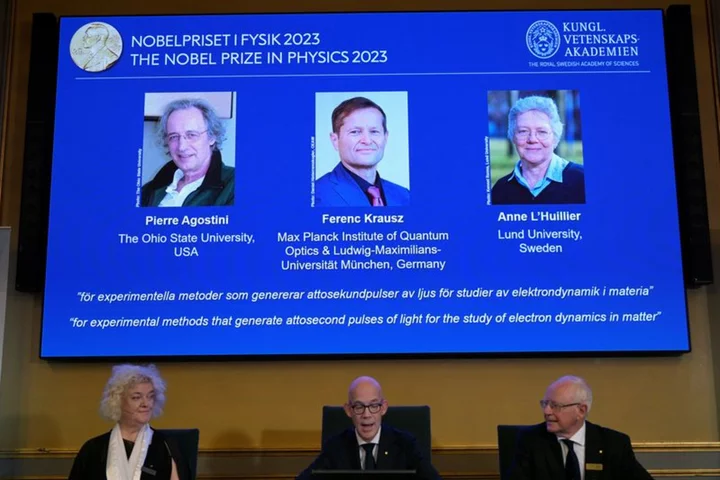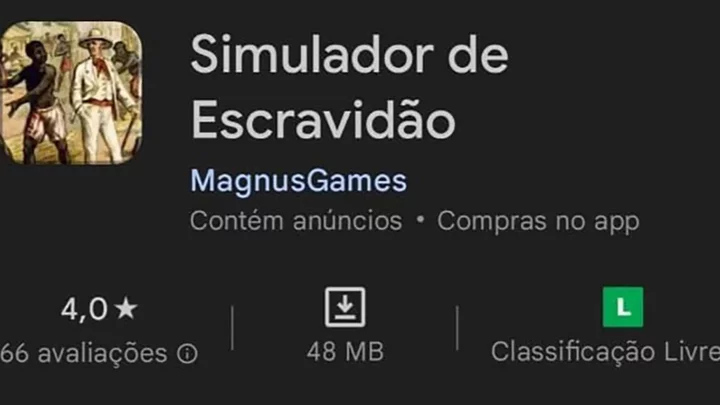By Niklas Pollard and Johan Ahlander
STOCKHOLM (Reuters) -Scientists Pierre Agostini, Ferenc Krausz and Anne L'Huillier won the 2023 Nobel Prize in Physics for creating ultra-short pulses of light that can give a snapshot of changes within atoms, potentially leading to better detection of disease.
The prize-awarding academy said their studies had given humanity new tools for exploring the movement of electrons inside atoms and molecules, a phenomenon that was long thought impossible to trace.
Changes in electrons occur in a few tenths of an attosecond, a unit so short that there are as many attoseconds in one second as there have been seconds since the birth of the universe.
"The ability to generate attosecond pulses of light has opened the door on a tiny, extremely tiny, time scale and it's also opened the door to the world of electrons," said Eva Olsson, member of the Nobel Prize in Physics Selection Committee.
There are potential applications of the findings in many different areas. In electronics, it is important to understand and control how electrons behave in a material.
The field also holds promise in areas such as a new in-vitro diagnostic technique to detect characteristic molecular traces of diseases in blood samples, the academy said.
Hungarian-born Krausz, whose team generated the first ultra-fast pulses in the early 2000s, has likened attosecond physics to a fast-shutter camera where the short light flashes allow a freeze frame look within the microcosm.
"Just as you try to photograph a Formula 1 racing car with a fast camera, for example, as it runs through the finish line. You need a camera to take sharp snapshots and reconstruct the movement," he told Reuters at the Max Planck Institute of Quantum Optics in Garching, Germany, where he is director. "This is exactly the concept we use for the fastest movements that happen in nature outside the atomic nucleus, which is the movement of electrons."
L'Huillier, who received word she had won the prize in the middle of a lecture, said, "it is really a prestigious prize and I'm so happy to get it. It's incredible." She proceeded with the lecture after the news, a half hour she described as "a bit difficult".
Only the fifth woman to win a Nobel physics prize, French-born L'Huillier works at Lund University in Sweden, while Agostini, who was also born in France, is a emeritus professor at Ohio State University in the United States.
The two French winners were congratulated by French President Emmanuel Macron, who said on social media: "What pride for our Nation!"
INSIDE THE ATOM
L'Huillier discovered a new effect from the interaction of laser light with atoms in a gas in experiments beginning in the 1980s. Agostini and Krausz then demonstrated how this could be used to create shorter light pulses than previously possible.
While Krausz and his colleagues in Austria were working on a technique that could select a single pulse, Agostini and his group in France succeeded in producing and investigating a series of consecutive light pulses, like a train with carriages.
These experiments all showed that attosecond pulses could be observed and measured, and could be used in new experiments.
Krausz said he was trying to take in the reality of winning the award.
"I did not expect it," he said. "I am overwhelmed."
The academy was unable to immediately reach Agostini, who was in Paris, to give him the news.
"My daughter called me and she was asking: 'Is it true you have the Nobel prize?'," he said in an interview at his Paris apartment. "Of course I told her, 'No, this can't be true'."
Physics is the second Nobel to be awarded this week after Hungarian scientist Katalin Kariko and U.S. colleague Drew Weissman won the medicine prize for making mRNA molecule discoveries that paved the way for COVID-19 vaccines.
Created in the will of dynamite inventor and businessman Alfred Nobel, the prizes for achievements in science, literature and peace have been awarded since 1901 with a few interruptions, becoming arguably the highest honour for scientists everywhere.
While the award for peace can take the limelight, the physics prize has also often taken centre stage with winners such as Albert Einstein and awards for science that has fundamentally changed how we see the world.
Announced on consecutive weekdays in early October, the physics prize announcement will be followed by ones for chemistry, literature, peace and economics, the latter a later addition to the original line-up.
($1 = 11.0129 Swedish crowns)
(Reporting by Niklas Pollard, Simon Johnson and Johan Ahlander in Stockholm; additional reporting by Terje Solsvik in Oslo, Krisztina Than in Budapest, Elizabeth Pineau in Paris, Ayhan Uyanik and Christine Uyanik in Garching, Charlotte Van Campenhout in Amsterdam, and Michaela Cabrera in Paris; Editing by Alexandra Hudson, Rosalba O'Brien and Mark Potter)









